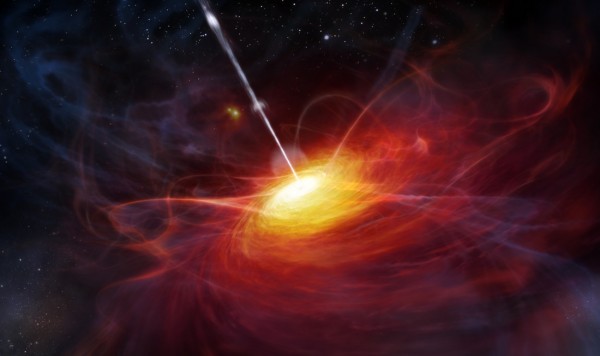By Ana Verayo, | September 14, 2016

An artist’s rendering of a very distant quasar
In a single discovery, astronomers have detected 63 new quasars - a first for a scientific study.
According to lead author of the study, astronomer Eduardo Bañados from the Carnegie Institution for Science, the recent survey can potentially double the known number of quasars existing within the early universe.
Like Us on Facebook
These recently identified quasars are thought to have been in existence when the universe was just 1 billion years old.
Quasars are powerful cosmic objects that send out beams of extremely brilliant light. Within their core are active supermassive black holes. They are also considered to be the brightest objects in the universe.
Researchers consider quasars as "lighthouses" as they illuminate the universe and can provide crucial clues about the ancient universe.
What happens within a quasar? Quasars consume colossal amounts of matter forming an accretion disk around them, producing powerful beams of X-rays that can be seen from a distance of 13 billion light-years away.
In the new study, the scientists express hope that these new 63 quasars will offer important insights into how the early universe evolved and how the first light came to be.
During the Big Bang event, matter within the universe exploded, and as the primordial universe began to cool down, the entire universe was pitch black. With the emergence of gravitational forces, hydrogen atoms condensed into the first light of the universe.
Now, astronomers suggest that these quasars could be the first sources of light in the universe.
Bañados stated that one of the greatest mysteries of astronomy is how the earliest light in the universe emerged, and these 63 very bright quasars are the best tools that can help astronomers probe the early universe.
This study has been published in the Astrophysical Journal Supplement Series.
-
Use of Coronavirus Pandemic Drones Raises Privacy Concerns: Drones Spread Fear, Local Officials Say

-
Coronavirus Hampers The Delivery Of Lockheed Martin F-35 Stealth Fighters For 2020

-
Instagram Speeds Up Plans to Add Account Memorialization Feature Due to COVID-19 Deaths

-
NASA: Perseverance Plans to Bring 'Mars Rock' to Earth in 2031

-
600 Dead And 3,000 In The Hospital as Iranians Believed Drinking High-Concentrations of Alcohol Can Cure The Coronavirus

-
600 Dead And 3,000 In The Hospital as Iranians Believed Drinking High-Concentrations of Alcohol Can Cure The Coronavirus

-
COVID-19: Doctors, Nurses Use Virtual Reality to Learn New Skills in Treating Coronavirus Patients







